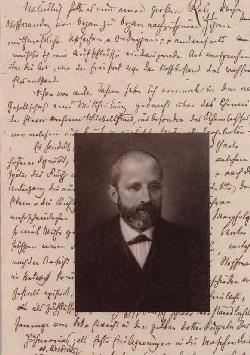In their recent book, "What is Life", Lynn
Margolis and Dorion Sagan with a forward by Niles Eldridge (all respectable
scientific writers) and published in 2000 by the University of California
Press, opens with the statement: "Half a century ago, before the discovery
of DNA ...." The reference is to the 1953 paper by Watson & Crick
in which they proposed the molecular structure of DNA and for which they
eventually received the Nobel Prize (Watson JD and Crick FHC, Molecular
Structure of Nucleic Acid, Nature, 1953, Vol. 171, Pg. 737). That paper
reports the discovery of the structure of DNA not the discovery of DNA,
itself. The discovery was made, almost 100 years earlier in 1869, by the
little known, German scientist, Friedrich Miescher. Miescher's work was
a phenomenal accomplishment, given the chemistry of the time; and his accomplishment
is routinely overlooked in reciting the history of genetics.
Margulis and Sagan are not alone in this serious neglect.
In another recent paper in the prestigious journal, Science, "Genomics:
Journey to the Center of Biology" (Science, 10 March 2000, Vol. 287,
Pg. 1777-82), the history of genomic science is reviewed. The authors, Lander
& Weinberg, cite all the way back to Hippocrates, Aristotle, Leewenhoek,
Mendel, and up through the most recent work of Strittmatter, Ting, and others;
but still no mention of Miescher. And the same oversight is made my many
other scientific authorities.
Here are the facts. In 1866, Gregor Mendel reported
his experiments with peas and his formulation of the general laws of heredity.
It was published in an obscure journal and remained unknown for almost 40
years. However, at about the same time as Mendel's report, Miescher, a young
chemist in the lab of Hoppe-Seyler at the University of Tübingen, Germany,
initiated experiments in the chemical composition of the nucleus. This was
a radical divergence from the prevailing notions of the time, when the nucleus
was of little interest, and it was assumed that the only biological chemicals
were fats, sugars, and protein. Using a dilute acid, Miescher disintegrated
pus cells which he collected from the adjacent hospital, finding that the
nuclei settled at the bottom of the flash. That lead him to conclude that
the nuclear material had a specific gravity greater than protein and other
constituents and was a different substance which he called "nuclein".
Further, he proved that this substance was rich in phosphorus, and therefore
a unique substance. His findings were so exceptional, that the lab director
withheld publication for 3 years during which time he personally reproduced
and confirmed the experiment. (Miescher JF; Uber die chemische Zusammensetzung
der Eiterzellen; Med-chem. Untersuchungen; 1871, Vol.4, Pg.441-460).
Miescher went on to spend the rest of his short life,
expanding this original work. Years later, in a letter to one of his professors,
he wrote: "I know better than anyone else that my work is only the
preliminary study to a future histochemistry." Little did he understand
the eventual significance of his contribution. Melvin Calvin, the scientist
who discovered the biochemistry of how photosynthesis works, used as a motto
for his lab that when you have all of the facts in front of you, science
is easy to do; but when you have only some of the facts, and of those, you
are not sure which ones are correct, then science is a real challenge. From
that perspective, Miescher was one of the great scientific geniuses. By
the time Watson & Crick came along, virtually all of the facts were
in place.
Links & References
Friedrich Miescher (1844-1895) A
brief biography.
Slide
presentation on the history of DNA.
References:
Greenstein JP; Friedrich Miescher 1844-1895, founder of nuclear chemistry;
Sci. Monthly 57: 523, 1943
James J; Miescher's Discoveries of 1869 - A Centenary of Nuclear Chemistry;
The Journal of Histochemistry and Cytochemistry; 1970, Vol. 18, No. 3, Pg.
217-219.
Virginia Morell, Science 25 June pg. 2107, 1999 "Charles Darwin
... wrote 100 years before DNA was discovered."
Gregor Mendel' original paper in the Journal of the Brunn Society of
Natural Science (Verh. Naturforsch. Brunn, vol. 4, page 3, 1866)
1944 Avery OT, MacLeod CM, and McCarty; Journal of Experimental Medicine,
bol 79, p.137, 1944) provides the definitive proof that nuclear DNA is the
hereditary substance, amplified by Hershey-Chase in 1952. |
 DoctorInternet
DoctorInternet
 |